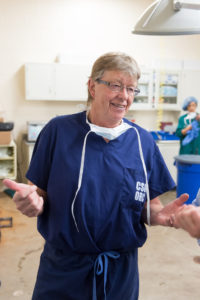
Dr. Laurie Goodrich never met Barbara Cox Anthony, the late philanthropist and president of the James M. Cox, Jr. Foundation, but she is confident they would have gotten along well. Recently appointed to the Barbara Cox Anthony University Chair in Orthopaedic Research, Goodrich admires the generosity and altruism of the chair’s namesake and is honored to be taking on this new role.
“She was supportive of education and humble, as well. I just love that I’m in a chair donated by that kind of individual,” Goodrich said. “She was also an avid athlete who loved the outdoors – like me – and I would have loved to have met her.”
Goodrich is an orthopaedic surgeon and the director of the Orthopaedic Research Center at Colorado State University and is only the second person to hold the Barbara Cox Anthony University Chair in Orthopaedic Research. Goodrich’s appointment follows Dr. Wayne McIlwraith’s, the inaugural chairholder, who founded the Orthopaedic Research Center and is credited for the growth and preeminence of CSU’s equine orthopaedics program.
The Barbara Cox Anthony University Chair in Orthopaedic Research enhances the chairholder’s education, research, and service programs. McIlwraith was instrumental in securing the original gift that made the chair – and the ongoing academic support associated with it – possible.
Helping horses and humans
Like Anthony, bragging doesn’t come naturally to Goodrich, despite her long list of professional accomplishments in the field of equine orthopaedic surgery. A proponent of the power of collaboration, she instead prefers to share success with her colleagues, peers, and mentees.
“Any of the projects I’ve led have been in collaboration with people within and beyond CSU,” Goodrich said. “The success of these kinds of programs is about building relationships, being trustworthy, and highlighting altruism.”
Goodrich’s research specialty is in regenerative medicine, gene therapies, and biologics to improve joint and bone repair. Her focus is on genetically modifying mesenchymal stem cells – stem cells found in bone marrow that help make and repair skeletal tissues – to suppress inflammation that commonly occurs in joint diseases like osteoarthritis in horses.
Though she works primarily with horses, Goodrich is a translational scientist, which means she seeks to develop medical solutions that benefit both animals and people. As a clinician, the work Goodrich does in the Orthopaedic Research Center with her team drives the veterinary work she performs on the clinic floor as a surgeon, and vice versa.
“So many of the problems we face in equine orthopaedics, humans are facing, as well,” Goodrich said. “Advancements in one species could mean advancement in another species.”
Through partnerships with other equine researchers in the field, her work extends beyond the CSU campus. For example, a collaboration with the Gene Therapy Center at the University of North Carolina that began while Goodrich was nearing completion of her Ph.D. at Cornell University is still ongoing (now funded by the Department of Defense), with goals of bringing a new therapy to the clinic floor, as well as mentoring and developing young scientists. Goodrich models the same skills she hopes to help develop in her mentees: consistent communication, respect, and follow through.
The power of people
After over 16 years at CSU, Goodrich has mentored many aspiring scientists, and what brought her to the university in the first place was the work of McIlwraith, one of her own long-time mentors.
Goodrich met McIlwraith for the first time when she attended a lecture he gave on arthroscopy and orthopaedic research while she was in veterinary school. Inspired, she turned her focus toward the same specialty and never looked back.
“When he started to speak, I actually moved my seat down to the front row because I wanted to see what this Kiwi lecturer was all about,” Goodrich said. “From that point on he’s been a hero figure in my life.”
McIlwraith sees mentorship as an essential part of growing a program and leaving a legacy. And Goodrich is a natural next step forward for equine orthopaedics at CSU.

“You’ve got to work hard to keep good people,” McIlwraith said. “We want to move forward and grow the program more, and I think Dr. Goodrich is capable of it – she’ll continue to build on what we’ve done.”
McIlwraith had worked with Anthony since the late 1990s, when he treated her horses and facilitated care for a few of her dogs. It was the beginning of a relationship that would culminate in the creation of two university chairs, including the one Goodrich now holds.
“Barbie was unique. A great donor but so humble and kind, and we quickly became close friends,” McIlwraith said. This friendship continued with Anthony’s son Jim Kennedy, who continues to support programs at CSU.
“With this first endowed chair, we were able to keep good people – like residents and Ph.D. candidates – beyond their training,” McIlwraith said.
Goodrich plans to recruit new, diverse talent to enhance the program’s already impressive capabilities.
“Recruitment will be an important part of our future, and I think diversity begets bigger and bigger talents,” Goodrich said.
McIlwraith agrees. “Recruitment will ensure that the program continues to excel as the premiere program globally,” he said.
As someone who continues to benefit from all the Orthopaedic Research Center has to offer – mentorship, financial support, and teamwork – Goodrich is determined to use her new role to give back to the community that got her this far.
“My success is the success of others,” Goodrich said. “When your mentees go on and do greater things than you, that’s how you know you were successful.”